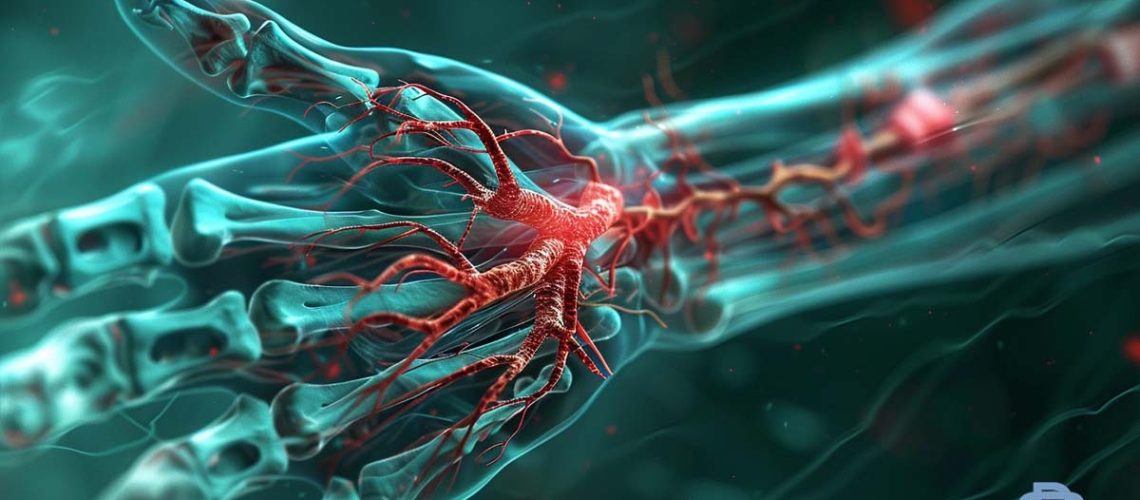Feeling pinched? Entrapment neuropathy explained.
Ever felt a tingling or numbness in your hands or feet? It could be entrapment neuropathy, a condition where a nerve gets squeezed by surrounding tissues.
This can happen in various areas of the body, from your wrist (carpal tunnel syndrome) to your ankle (tarsal tunnel syndrome). The symptoms can range from mild discomfort to severe pain and weakness.
While the exact cause might be unclear, repetitive motions, injuries, and even tight clothing can contribute.
The good news? Treatments like physical therapyTreatment approaches like therapeutic exercises, hot/cold therapies and manual joint manipulation to improve mobility and reduce muscul... More, medication, and even surgery can often help manage the symptoms and improve your quality of life.
If you’re experiencing persistent numbness, tingling, or pain, talk to your doctor to see if entrapment neuropathy could be the culprit. Early diagnosis and treatment can make a big difference.
What is Entrapment Neuropathy
Ever felt a tingling or numbness in your hands or feet? It could be entrapment neuropathy, a condition where a nerve gets squeezed by surrounding tissues.
This can happen in various areas of the body, from your wrist (carpal tunnel syndrome) to your ankle (tarsal tunnel syndrome). The symptoms can range from mild discomfort to severe pain and weakness.
While the exact cause might be unclear, repetitive motions, injuries, and even tight clothing can contribute.
The good news? Treatments like physical therapy, medication, and even surgery can often help manage the symptoms and improve your quality of life.
If you’re experiencing persistent numbness, tingling, or pain, talk to your doctor to see if entrapment neuropathy could be the culprit. Early diagnosis and treatment can make a big difference.
Entrapment neuropathy frequently occurs when peripheral nerves become compressed or trapped by surrounding tissues, leading to a range of symptoms including pain, numbness, and muscle weakness. This condition arises from the undue pressure on the nerves, often resulting in neuropathic painPain caused by nerve damage or abnormal nerve signaling disruption. Common in diabetes, shingles, and chemotherapy. that can greatly impact an individual’s quality of life. Among the various forms it can take, carpal tunnel syndrome is prominently prevalent, highlighting the widespread nature of this issue.
The process of diagnosing entrapment neuropathy is multifaceted, involving physical examinations, nerve conduction studies, and imaging techniques such as MRI. Specific tests, including Phalen’s and Tinel’s, also play important roles in identifying the precise location and extent of nerve compression.
Once diagnosed, the approach to treatment can vary depending on the severity and cause of the entrapment. Conservative measures, including bracing, activity modification, and physical therapy, often serve as the initial steps. However, for cases where these interventions fail to provide relief, surgical intervention may be necessary to decompress the affected nerve and alleviate symptoms. The goal of treatment, whether through conservative means or surgery, is to relieve the compression, mitigate symptoms, and restore function.
Causes
Several factors can lead to the development of entrapment neuropathy, including repetitive joint movements, traumatic injuries, and physiological changes. This condition, primarily associated with nerve compression syndromes, results from various mechanisms that disrupt normal nerve function, leading to characteristic entrapment neuropathy symptoms.
- Repetitive Motion and Traumatic Injuries:
- Repetitive motion in joints is a prevalent cause, as it can lead to nerve compression. Activities that require continuous or repetitive movements can gradually cause tissues to compress nearby nerves, leading to symptoms.
- Traumatic injuries can also precipitate this condition by causing swelling or shifting of bones and ligaments, which in turn compresses the nerves.
- Tumors, Cysts, and Physiological Changes:
- The presence of tumors or cysts pressing against nerves can obstruct their normal function and contribute to the development of symptoms.
- Hormonal changes, especially during pregnancy, can loosen ligaments, increasing the risk of nerve entrapment. This is compounded by the added pressure from the growing fetus.
- Autoimmune Conditions and Inflammation:
- Conditions like rheumatoid arthritis, which cause joint inflammation, can lead to nerve entrapment in the affected areas. The inflammation can alter the structural integrity around the nerves, leading to compression.
Symptoms of Entrapment Neuropathy
Understanding the myriad causes of entrapment neuropathy sets the stage for a deeper examination of its symptoms, which range from pain along the nerve path to muscle weakness. Entrapment neuropathy symptoms manifest diversely, reflecting the complexity of this condition. The affected individuals often experience a variety of symptoms, which can impact their daily activities and quality of life.
The primary symptoms include:
- Pain along the affected nerve pathway: This pain can range from a mild ache to a sharp, burning sensation, often worsening with movements or activities that stress the involved nerve.
- Numbness and tingling: These sensations usually occur in the area supplied by the compressed nerve, leading to an uncomfortable feeling of pins and needles.
- Muscle weakness and skin changes: Impaired nerve function can result in muscle weakness, making it difficult to perform specific activities. Additionally, the skin over the affected area may show signs of hypersensitivity or altered texture.
These symptoms of entrapment neuropathy underscore the importance of recognizing and addressing the underlying causes. The manifestation of pain, numbness, tingling, muscle weakness, and skin changes, particularly when they worsen with specific activities or positions, points to the need for a thorough evaluation and targeted intervention.
Exams and Tests
To accurately diagnose entrapment neuropathy, healthcare professionals employ a variety of exams and tests designed to pinpoint nerve compression and assess its severity. These evaluations range from simple physical examinations to advanced imaging techniques, each playing a critical role in identifying the specific type and location of nerve entrapment. Particularly in conditions like carpal tunnel syndrome, a precise diagnosis can greatly influence the management and outcome of treatment.
Key diagnostic tools include:
- Physical Examination and Specific Tests:
- Phalen’s Test, which involves wrist flexion to reproduce carpal tunnel syndrome symptoms.
- Tinel’s Test, where tapping over a nerve elicits tingling or numbness, indicating nerve irritation.
- Neurological Tests:
- These evaluate touch sensation and the ability to differentiate temperature, essential for evaluating nerve function and detecting dysfunction in cases of nerve entrapment.
- Imaging Tests:
- Tools such as X-ray, MRI, and ultrasound help visualize the extent of nerve compression. Advanced techniques like electromyogram and Nerve Conduction Study provide detailed insights into nerve damage and its severity, guiding the approach to treatment.
Treatment
Having explored the various methods to diagnose entrapment neuropathy, the focus now shifts to the treatment options available for managing this condition. Treatment strategies for entrapment neuropathy are centered on alleviating the pressure on the affected nerve to prevent further damage and enhance nerve recovery. Essential measures, including bracing and activity modifications, play a critical role in the early stages of treatment. These interventions aim to halt the mechanical injury to the nerves in the arms and legs, potentially stemming from repetitive motions or sustained positions that exacerbate the entrapment syndrome.
When essential approaches prove insufficient, surgical intervention becomes a viable option. The surgery for entrapment neuropathy typically involves cutting the ligament that is compressing the nerve, thereby relieving the pressure and allowing for nerve recovery. This procedure has been highly effective, with a significant number of patients regaining full nerve function post-surgery. The decision to proceed with surgery is usually made when symptoms persist or worsen, indicating that the entrapment is not responding to essential measures. Ultimately, the goal of treatment, whether through surgical or non-surgical means, is to restore nerve function and alleviate the symptoms associated with the tunnel syndrome.
Prognosis Based on Symptoms
The prognosis for individuals with entrapment neuropathy varies greatly, primarily influenced by the severity of symptoms and the timeliness of intervention. The extent of nerve damage, the underlying cause of the condition, and the efficacy of treatment strategies all play critical roles in determining outcomes. Early diagnosis is paramount for preventing long-term nerve damage and facilitating a more favorable prognosis.
Key factors affecting prognosis include:
- Severity of Symptoms: Mild cases may experience significant improvement with conservative management, whereas more severe symptoms often require surgical intervention to alleviate nerve compression and restore function.
- Underlying Cause: Identifying and addressing the root cause of nerve compression is essential. Conditions that are diagnosed early and treated appropriately tend to have better outcomes.
- Treatment Strategies: A combination of medical management, physical therapy, and possibly surgical intervention can help relieve symptoms. Function restoration is a primary goal, with regular follow-up necessary to monitor progress and adjust treatment plans as needed.
In all cases, a proactive approach towards diagnosis and treatment, coupled with regular follow-up, can mitigate the risk of long-term nerve damage and improve overall prognosis.
When Should I Contact Professional Doctor?
Recognizing the early signs of entrapment neuropathy and seeking prompt medical consultation can greatly influence the effectiveness of treatment and overall prognosis. If you experience persistent numbness, tingling, or weakness in your limbs, it is important to contact a professional doctor. These symptoms may indicate the early stages of nerve entrapment syndrome, a condition that requires medical attention to prevent further complications.
Should you have shooting pain that follows a specific nerve pathway, it is another clear signal that professional evaluation is needed. This type of pain often points to an underlying issue with nerve entrapment that warrants immediate medical advice. Similarly, observing muscle atrophy or a significant loss of strength in a specific area is a concerning symptom that should prompt a doctor’s visit. These physical changes can suggest the progression of the condition and the need for medical intervention.
Moreover, if your symptoms worsen with specific activities or movements, it highlights the relationship between your actions and the nerve entrapment, necessitating professional guidance. Understanding when to seek medical advice is paramount in managing nerve entrapment syndrome effectively and preventing its escalation.
Can Entrapment Neuropathy Be Prevented with a timely Treatment?
With timely intervention, it is possible to prevent the progression of entrapment neuropathy and avoid permanent nerve damage. Addressing the symptoms at an early stage is important for achieving better outcomes and ensuring a faster recovery. When entrapment neuropathy is caught early, nonsurgical interventions can be highly effective in managing symptoms and preventing further nerve damage.
To prevent the progression of entrapment neuropathy, consider the following strategies:
- Nonsurgical Interventions: Utilize treatments such as bracing, activity modification, and physical therapy. These approaches can alleviate stress on the affected nerve and improve symptoms without the need for surgical intervention.
- Identify and Treat the Underlying Cause: It is important to determine the exact cause of nerve compression and address it directly. This may involve lifestyle changes, ergonomic adjustments, or medical treatments tailored to the specific underlying issue.
- Regular Monitoring and Follow-Up: Stay in close contact with healthcare providers to ensure timely adjustments to the treatment plan. Regular check-ups allow for the monitoring of progress and the early detection of any potential complications.

